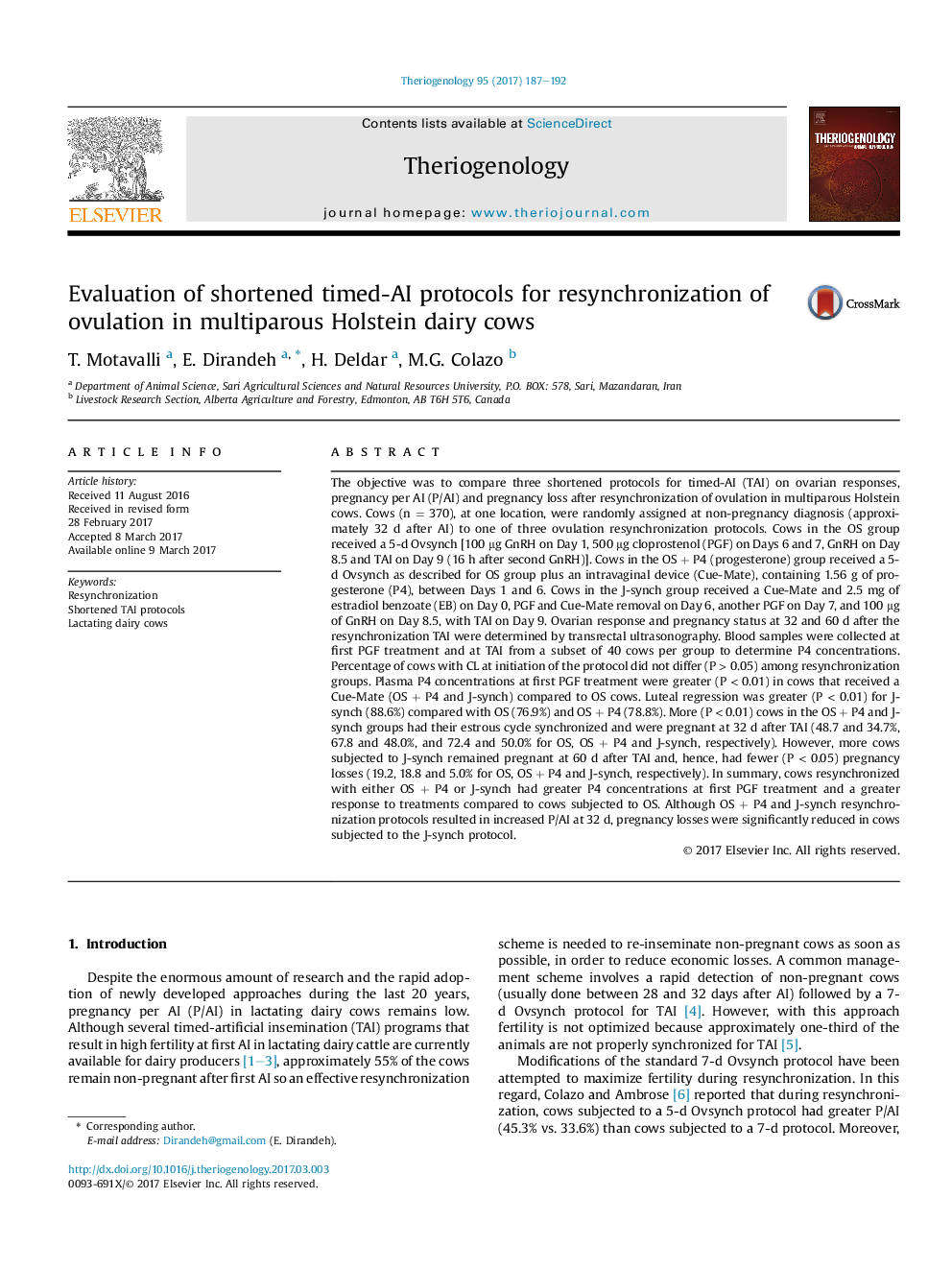| کد مقاله | کد نشریه | سال انتشار | مقاله انگلیسی | نسخه تمام متن |
|---|---|---|---|---|
| 5523390 | 1546074 | 2017 | 6 صفحه PDF | دانلود رایگان |

The objective was to compare three shortened protocols for timed-AI (TAI) on ovarian responses, pregnancy per AI (P/AI) and pregnancy loss after resynchronization of ovulation in multiparous Holstein cows. Cows (n = 370), at one location, were randomly assigned at non-pregnancy diagnosis (approximately 32 d after AI) to one of three ovulation resynchronization protocols. Cows in the OS group received a 5-d Ovsynch [100 μg GnRH on Day 1, 500 μg cloprostenol (PGF) on Days 6 and 7, GnRH on Day 8.5 and TAI on Day 9 (16 h after second GnRH)]. Cows in the OS + P4 (progesterone) group received a 5-d Ovsynch as described for OS group plus an intravaginal device (Cue-Mate), containing 1.56 g of progesterone (P4), between Days 1 and 6. Cows in the J-synch group received a Cue-Mate and 2.5 mg of estradiol benzoate (EB) on Day 0, PGF and Cue-Mate removal on Day 6, another PGF on Day 7, and 100 μg of GnRH on Day 8.5, with TAI on Day 9. Ovarian response and pregnancy status at 32 and 60 d after the resynchronization TAI were determined by transrectal ultrasonography. Blood samples were collected at first PGF treatment and at TAI from a subset of 40 cows per group to determine P4 concentrations. Percentage of cows with CL at initiation of the protocol did not differ (P > 0.05) among resynchronization groups. Plasma P4 concentrations at first PGF treatment were greater (P < 0.01) in cows that received a Cue-Mate (OS + P4 and J-synch) compared to OS cows. Luteal regression was greater (P < 0.01) for J-synch (88.6%) compared with OS (76.9%) and OS + P4 (78.8%). More (P < 0.01) cows in the OS + P4 and J-synch groups had their estrous cycle synchronized and were pregnant at 32 d after TAI (48.7 and 34.7%, 67.8 and 48.0%, and 72.4 and 50.0% for OS, OS + P4 and J-synch, respectively). However, more cows subjected to J-synch remained pregnant at 60 d after TAI and, hence, had fewer (P < 0.05) pregnancy losses (19.2, 18.8 and 5.0% for OS, OS + P4 and J-synch, respectively). In summary, cows resynchronized with either OS + P4 or J-synch had greater P4 concentrations at first PGF treatment and a greater response to treatments compared to cows subjected to OS. Although OS + P4 and J-synch resynchronization protocols resulted in increased P/AI at 32 d, pregnancy losses were significantly reduced in cows subjected to the J-synch protocol.
Journal: Theriogenology - Volume 95, June 2017, Pages 187-192